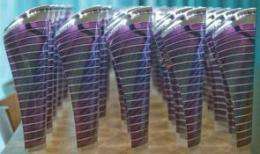November 9, 2009 weblog
Solar Cells with LEDs Provide Inexpensive Lighting

(PhysOrg.com) -- Of the 1.5 billion people in developing countries who do not have electricity, many rely on kerosene lamps for light after the sun goes down. But now, researchers from Denmark have designed an LED lamp that runs on solar cells, which costs less than one-quarter of the annual cost of using kerosene lighting. The solar-LED lamps are expected to last at least a year, making them an affordable alternative to kerosene.
Frederik Krebs and other scientists at the Ris? National Laboratory for Sustainable Energy in Denmark have developed an inexpensive way to integrate solar cells, LEDs, and ultrathin lithium batteries to create a lamp that can produce reading-quality light. The lamp's polymer solar cells and circuitry are printed onto large flexible plastic films, and then the LEDs, flat batteries, and diodes are mounted using silver epoxy. After being encapsulated in a second sheet of film, the sheets are rolled up and snapped together at the corners with metal fasteners.
The devices are very inefficient by today's standards, capturing just 1-2% of the energy that hits them. Still, they're cheap enough to be practical in some off-grid villages. In rural areas of Africa, Asia, and Latin America, the average household spends $40-$80 per year for kerosene lamps. Even the cheapest solar-LED lighting devices on the market today cost about a year's worth of kerosene, which would not be very advantageous. But the total cost of the Denmark scientists' solar-LED lamps is only about $27, and they think they can manufacture an improved version for about $10. They estimate that using cheaper labor in China could reduce the cost again by as much as 50%.
Last summer, the scientists field-tested 196 prototypes with the help of children who attended a Danish-run summer school in Zambia. The results showed that some of the lamps had problems due to excessive flexing and light quality degrading after 10 to 20 minutes, which the scientists are fixing by repositioning the solar cells and adding circuitry to deliver power to the LEDs at a constant current. The researchers plan to test improved versions of the lamps in Mali and Malawi.
via: IEEE Spectrum
© 2009 PhysOrg.com



















